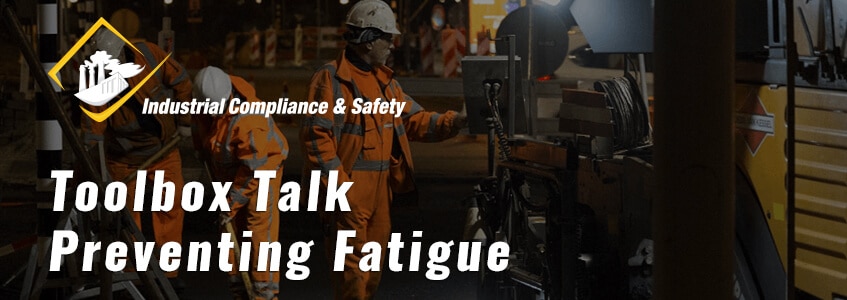Date: ____________________________________
Supervisor: _______________________________
Company Name: _____________________________
Job Name: ______________________________
Fatigue is often a major contributing factor in workplace incidents and injuries. The negative effects of fatigue aren’t often discussed, as fatigue is difficult to quantify in accident investigations and reports. Because of this, it is best to look at fatigue as a silent, slow killer. With this Toolbox Talk, you can encourage your employees to take care of themselves, and you can convey just how important it is to be well-rested for a day of work.
Guidelines for Discussion:
In our lives, we all face times where we sleep less than usual. Maybe you have a newborn baby at home and haven’t yet established a sleeping pattern. Maybe one of your parents is sick, and you stay up trying to calculate the cost of care. Maybe nothing unusual is happening, but you are just having a hard time quieting your mind. All of these things are understandable. However, you must care for yourself, especially when your job involves manual labor. Life will always throw you some curveballs, but it is important, for your sake, to not allow a few nights of restlessness to become a trend.
Fatigue is the condition of being physically or mentally tired. In extreme cases, fatigue can lead to uncontrolled and involuntary shutdown of the brain.
If you are experiencing fatigue or chronic fatigue, this increases the likelihood of injury for both you and your coworkers. It is especially dangerous to operate machinery, such as the forklift, when you are fatigued. This brings danger to your entire workplace.
Fortunately, there are ways to fight fatigue:
- Get eight hours of sleep before starting work. If this isn’t possible, see if you can take a nap at some point during the day. A 10- or 20- minute nap can do wonders for your energy level.
- Go to bed at the same time each day. (Note to discussion leader: if your company rotates shifts, establish clockwise rotations (from day to evening to night). Clockwise rotating makes it easier for a worker to adjust to a changing sleep schedule.)
- Take all scheduled work breaks, even if you don’t feel tired at the time. Take this time to enjoy a snack. Stretch your body if you have been working in an uncomfortable or stagnant position.
- If you work the night shift or are trying to nap in the daytime, make sure you find a cool, dark, quiet location to sleep. Use earplugs, soft music, or a fan to block out any surrounding noise.
- If you are concerned about a prolonged period of disturbances in your sleep, or if you suspect you may have a sleep disorder, talk to a doctor.
- Eat a well-balanced diet. Begin your “day” or period of wakefulness with high protein foods and end with carbohydrates. Also, be aware that eating great quantities before bedtime can cause trouble sleeping.
- Talk to your family (wife, spouse, children) if there is a better way to balance responsibilities at home so that you sleep properly before work. Remember, fatigue may not seem very threatening, but it can lead to a severe mistake or injuries later. One conversation can save you a lot of pain in the future.
Additional Discussion Notes:
This toolbox talk is also a good time to check in with your employees about scheduling. Is everyone capable of working at any time of day? Are there any limitations - health or otherwise - that you should be aware of when making the schedule? Pose these questions, and allow employees to talk openly or privately either during or after this talk.
Safety Recommendations: _____________________
Job Specific Topics: ___________________________
Attendees:
____________________________________
____________________________________
____________________________________
____________________________________
____________________________________
____________________________________
____________________________________
____________________________________
____________________________________
____________________________________
____________________________________
____________________________________
____________________________________
____________________________________
____________________________________
____________________________________
____________________________________
____________________________________
____________________________________
____________________________________
____________________________________
____________________________________
Disclaimer
The information contained within this document (both the online and downloadable version) is provided for informational purposes only. Nobody shall take this as a comprehensive or exhaustive resource on this topic. This material is believed to be accurate, however, the information has been compiled from multiple sources, and so Industrial Compliance & Safety assumes no responsibility for the accuracy of this information. We encourage you to consult experts about this specific Toolbox Talk to ensure you are compliant with any and all safety regulations and processes. In no event does the content of this document supersede any applicable local, state, or federal statutes or regulations.





